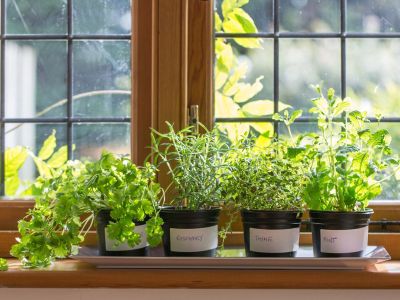Starting an Indoor Herb Garden
Before starting your herb garden inside, decide what you’ll be growing in your indoor herb garden. Most popular herbs can be grown indoors. Some herbs you might want to grow are:
Basil Rosemary Cilantro Chives Oregano Parsley Sage Thyme Mint
If you’re new to growing herbs indoors, you may want to start with just two or three of your favorite herbs and add more as you become more confident. You’ll also need to choose a container for your indoor herb garden to grow in. The container should either have drainage holes or should be deep enough that you can add rocks at the bottom to create a drainage reservoir for excess water to run into. Herbs that are grown indoors cannot sit in waterlogged soil or they will die. The soil you use in your herb garden inside should be rich in organic material. A good quality potting soil will work fine. Don’t use dirt from the garden, as this can get compacted easily and will strangle the herb plants. Once you have chosen the herbs you will grow indoors, the container, and soil, you can plant the herbs in the container as you would any other plant.
How to Grow Herbs Indoors
Once the herbs are planted, you’ll need to care for the herbs. Growing herbs indoors successfully has four important parts: light, temperature, water, and humidity.
Light for Herbs Growing Indoors
Herbs growing indoors need at least six hours of sunlight to grow well. If they don’t get enough sun, they’ll become leggy and start to lose their flavor. Place your indoor herb garden in the sunniest spot you can find. If you feel that spot won’t provide enough light, supplement the sunlight with a fluorescent bulb placed less than a foot (31 cm.) from the herbs. You may need to rotate the container that the indoor herb garden is growing in so that all of the herbs have a even amount of sun and do not grow crooked.
The Right Temperature for Growing Herbs Indoors
Most herbs cannot tolerate cold temperatures. The herbs will grow best inside if the temperature around them is 65 to 75 degrees F. (18-24 C.). Make sure your herb garden isn’t affected by drafts from windows or doors. Even small amounts of cold temperatures can kill some herbs.
Watering Indoor Herbs
Indoor herb gardens need to be watered regularly. They should never be allowed to dry out, but you should also not overwater them. Check your indoor herb garden daily and water it when the top of the soil just starts to feel dry– though if you stick your finger into the soil, the lower layer will still be damp. You can also add a bit of water soluble fertilizer to the water once a month to help the herbs get the nutrients they need.
Humidity for Indoor Herbs
Indoor herbs need both high humidity and excellent air circulation. Mist your herbs once a week or set them on a tray of pebbles filled with water to keep the humidity up. If you find your herbs are affected by mildew, you may want to consider adding a fan to keep the air circulation consistent.
